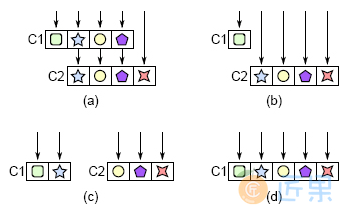具有相同签名的方法并不总是不好的。重要的是,每种新方法都应贡献重要的功能。直通方法很糟糕,因为它们不提供任何新功能。
分派器是一个示例,该示例对于一种方法调用具有相同签名的另一种方法很有用。调度程序是一种使用其参数选择要调用的其他方法之一的方法。然后将其大部分或所有参数传递给所选方法。调度程序的签名通常与其调用的方法的签名相同。即便如此,调度程序仍提供有用的功能:它可以选择其他几种方法中的哪一种来执行每个任务。
图 7.1:直通方法。在(a)中,类 C1 包含三个直通方法,这些方法只调用 C2 中具有相同签名的方法(每个符号代表一个特定的方法签名)。可以通过使 C1 的调用方像在(b)中那样直接调用 C2,通过在 C1 和 C2 之间重新分配功能以避免在(c)中的类之间进行调用,或者通过组合在(d)中的类来消除直通方法。 。
例如,当 Web 服务器从 Web 浏览器接收到传入的 HTTP 请求时,它将调用一个调度程序,该调度程序检查传入请求中的 URL 并选择一种特定的方法来处理该请求。某些 URL 可以通过返回磁盘上文件的内容来处理。其他人则可以通过调用诸如 PHP 或 JavaScript 之类的语言的过程来处理。分发过程可能非常复杂,通常由与传入 URL 匹配的一组规则来驱动。
只要每种方法都提供有用且独特的功能,几种方法都应具有相同的签名。调度程序调用的方法具有此属性。另一个示例是具有多种实现方式的接口,例如操作系统中的磁盘驱动程序。每个驱动程序都支持不同类型的磁盘,但是它们都有相同的接口。当几种方法提供同一接口的不同实现时,它将减少认知负担。使用其中一种方法后,与其他方法一起使用会更容易,因为您无需学习新的接口。像这样的方法通常位于同一层,并且它们不会相互调用。
Having methods with the same signature is not always bad. The important thing is that each new method should contribute significant functionality. Pass-through methods are bad because they contribute no new functionality.
One example where it’s useful for a method to call another method with the same signature is a dispatcher. A dispatcher is a method that uses its arguments to select one of several other methods to invoke; then it passes most or all of its arguments to the chosen method. The signature for the dispatcher is often the same as the signature for the methods that it calls. Even so, the dispatcher provides useful functionality: it chooses which of several other methods should carry out each task.
Figure 7.1: Pass-through methods. In (a), class C1 contains three pass-through methods, which do nothing but invoke methods with the same signature in C2 (each symbol represents a particular method signature). The pass-through methods can be eliminated by having C1’s callers invoke C2 directly as in (b), by redistributing functionality between C1 and C2 to avoid calls between the classes as in (c), or by combining the classes as in (d).
For example, when a Web server receives an incoming HTTP request from a Web browser, it invokes a dispatcher that examines the URL in the incoming request and selects a specific method to handle the request. Some URLs might be handled by returning the contents of a file on disk; others might be handled by invoking a procedure in a language such as PHP or JavaScript. The dispatch process can be quite intricate, and is usually driven by a set of rules that are matched against the incoming URL.
It is fine for several methods to have the same signature as long as each of them provides useful and distinct functionality. The methods invoked by a dispatcher have this property. Another example is interfaces with multiple implementations, such as disk drivers in an operating system. Each driver provides support for a different kind of disk, but they all have the same interface. When several methods provide different implementations of the same interface, it reduces cognitive load. Once you have worked with one of these methods, it’s easier to work with the others, since you don’t need to learn a new interface. Methods like this are usually in the same layer and they don’t invoke each other.
